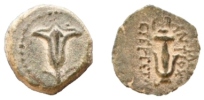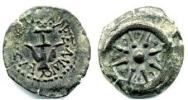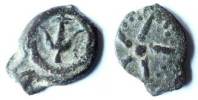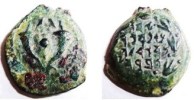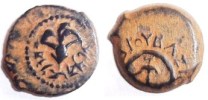The aniconic prohibition in the face of external pressures at the time of the Second Temple
When the Temple was rebuilt at the end of the 6th century BCE, the statue seems to have been replaced by a menorah[1]. According to the Book of Jeremiah (Jr 3:16-17) it was the very city of Jerusalem itself that had become the throne of YHWH. The Persian kings ruling an empire (539-532) stretching from Asia Minor to Central Asia scarcely interfered with the cults of the populations they ruled over. By contrast, the Greek dynasties that carved up the empire of Alexander the Great[2] after 323 exerted strong, imperative pressures.
First ruled by the Ptolemies[3] (305-198), the Southern Levant then fell to the Seleucidae[4] (198-141). This latest religious-political framework put a whole new complexion on the aniconic prohibition carried by the Torah. In the Greek and later Greco-Roman civilization, the iconographic culture relied on the primacy of the human form. Monarchs set up royal cults powered by an ideology that enabled them to assert their pretensions over their rivals. Such policies hung on the availability of a lavish iconographic backup, specifically in the shape of statues.
Some Jews were tempted by Hellenism, that is to say the adoption of the Greek language along with new lifestyles and customs, up to and including in the field of culture whilst others were fiercely opposed to it. Against a background of inner strife between rival Jewish clans, king Antiochus IV[5] promulgated in 168 discriminatory edicts, notably dedicating the Temple of Jerusalem to Olympian Zeus[6]. This decision entailed the erection of his statue in the Holy of Holies. The Jews responded with an uprising. Known as the Maccabeean[7] Revolt, it yielded the Hasmonean dynasty that gradually succeeded in shaking off the Seleucids' dominance, carving out a kingdom that extended to most of the Southern Levant. However it faced difficulties in establishing its legitimacy. The Maccabees dedicated the Temple anew to the Almighty with a hannukah[8], which entailed, amongst other things, the removal of the Greek divinity. The rejection of Hellenism, which triggered their rise to power was its mainstay. Before their own people they must make a show of their Jewish fervour driving an unconditional observance of the aniconic prohibition. They came up with an imaginative iconographic program that can be observed, for instance on their coinage. Instead of portraits of the monarchs, a common practice in the Hellenistic era, they had objects engraved on the coins that had a meaning among the Jews (pomegranate[9]) and the Greeks (aplustre[10]) or indeed all of the region's peoples (palm).
The issue flared up again when the Roman influence made itself more pressing. Pompey[11] ran a military expedition in 63 BCE before the kingdom was annexed in 6 AD. It became a Roman province bar for a period of phony independence between 41 and 44. At such time, fidelity to the emperor would find its expression in the imperial cult[12]. The province's Jews balked at the pressure. The ossuary[13] of the granddaughter of Caiaphas[14], a high priest officiating under Tiberius[15], attests to thoroughgoing observance of the aniconic prohibition: exclusively adorned with Jewish patterns fashionable at the time, it includes no figurative representation, let alone pagan ones. And when Caligula[16] sought to introduce a statue of his person inside the Holy of Holies, his plan caused such an uproar as to force him to back down.
Hasmonean coins. John Hyrcanus (Yehohanan 135-104 BCE) | Hasmonean coins. John Hyrcanus (Yehohanan 135-104 BCE) | Hasmonean coins. Alexander Jannaeus (103-76 BCE) |
Hasmonean coins. Alexander Jannaeus (103-76 BCE) | Hasmonean coins. Alexander Jannaeus (103-76 BCE) | Hasmonean coins. Alexander Jannaeus (103-76 BCE) |
Hasmonean coins. Alexander Jannaeus (103-76 BCE) | Hasmonean coins. Mattathias Antigonos (40-37 B.C.) | Hasmonean coins. Mattathias Antigonos (40-37 B.C.) |




